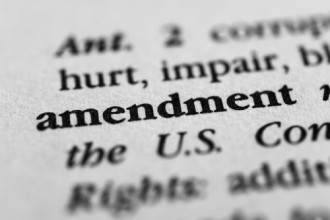
April 4, 2016
PTO Issues Final Rule Changes to IPR Proceedings
The PTO issued its long-anticipated rule changes for IPR and PGR proceedings. These rules follow up on immediate changes to the rules that were implemented about a year ago. Generally considered pro-Patent Owner changes to the rule, the new rules mark another phase in the evolution of IPR proceedings that have profoundly impacted the world of patent litigation. Below, we summarize each of the changes.
37 CFR §42.11 Duty of candor; signing papers; representations to the Board; sanctions. This section sets forth the requirements for signing papers before the PTAB and establishes that each paper must be submitted in good faith, similar to the requirements of Rule 11 from the Fed. R. Civ. P. The section also clarifies the procedure for filing a motion for sanctions for violating the good faith requirement.
37 CFR §42.23 Oppositions and replies. This section is amended to point out that a Petitioner reply may respond to arguments made in the corresponding Patent Owner Preliminary Response. The POPR was not included in the previous version of the rule.
37 CFR §42.24 Type-volume or page-limits for petitions, motions oppositions, and replies. For some filings, the length of the document will now be determined based on word count. For others, page limits still apply. Below is a summary of the current limitations:
i) IPR and Derivation Petitions: 14,000 words;
ii) PGR and CBM Petitions: 18,700 words;
iii) Patent Owner Preliminary Responses: 14,000 words;
iv) Patent Owner Responses to Petition: 14,000 words;
v) Replies to Patent Owner Responses to Petitions: 5,600 words;
vi) Motions: 15 pages;
vii) Opposition to Motions: 15 pages;
viii) Replies to Oppositions to Motions: 5 pages;
ix) Motions to Amend: 15 pages;
x) Opposition to Motions to Amend: 15 pages;
xi) Replies to Motions to Amend: 12 pages.
It is notable that, for the above page and word limits, tables of contents, tables of authorities, grounds for standing, mandatory notices, certificates of service or word count, and appendices of exhibits or claim listings do not count toward the limit. Statements of material facts to be admitted or denied do count toward the limit, but a response to such a statement does not count.
37 CFR §42.70 Oral argument. The time for serving demonstrative exhibits has been extended from five to seven business days.
37 CFR §42.100 Procedure; pendency. This section has been amended to allow a party to request that challenged claims be given a district court-type claim construction upon certification that the patent will expire within 18 months from the entry of the “Notice of Filing Date Accorded to Petition.”
37 CFR §42.107 Preliminary response to petition. This section has been amended to eliminate the prohibition against presenting new testimony evidence in the patent owner preliminary response.
37 CFR §42.108 Institution of inter partes review. In view of the change to section 107, this section is changed to make clear that the Board may rely upon any testimony provided with a patent owner preliminary response, but that any question of fact created by such testimony shall be viewed in the light most favorable to the petitioner. Further, upon a showing of good cause, the petitioner may seek to file a reply to the preliminary response.
37 CFR §42.200, 207, and 208. These sections are amended to make similar changes to PGR practice as discussed above in sections 100, 107, and 108 relative to IPR practice.
37 CFR §42.300. This section makes the same change to covered business method patents as is made to IPR practice in section 100, relative to claim construction.
Lastly, the commentary accompanying this rule package is interesting reading. The PTO explains its consideration of other issues, including additional discovery and real party-in-interest issues, including how these issues will be handled in the future.


































